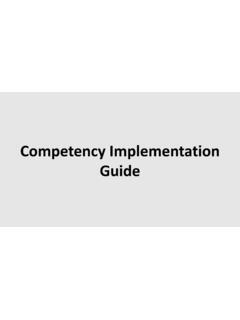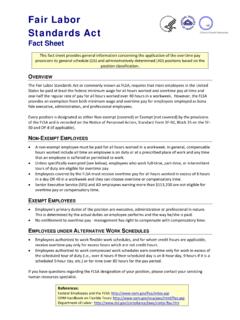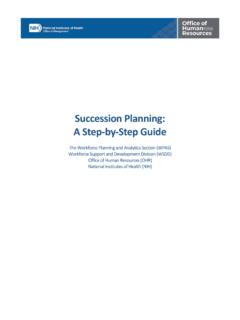Transcription of Employee Fact Sheet Discontinued Service Retirement
1 Employee Fact Sheet Discontinued Service Retirement Definition Discontinued Service Retirement (DSR) provides an immediate, possibly reduced, annuity for employees who are separated against their will. Under DSR, the key is the involuntary nature of the separation. Employees who are separated for cause on charges of misconduct or delinquency are not eligible for a DSR. The availability of DSR gives agencies a valuable tool to lessen the impact of an involuntary separation on a long- Service Employee . The final responsibility for determining whether a separation is involuntary for DSR purposes rests with the U. S. Office of Personnel Management (OPM). To qualify for Discontinued Service Retirement , an Employee must receive specific written notice of a proposed involuntary separation. Examples of involuntary separations include job abolishment, directed reassignment to a position outside the commuting area, and reduction in force. DSR applies to employees covered under both the Civil Service Retirement System (CSRS) and the Federal Employees Retirement System ( fers ).
2 Eligibility An Employee who is involuntarily separated is eligible for a Discontinued Service Retirement with an immediate annuity if all of the following conditions are met: 1. Minimum age and Service requirements At least age 50 with at least 20 years creditable Federal Service ; OR Any age with at least 25 years creditable Federal Service . 2. Minimum of five years of civilian Service . 3. Separation from a position subject to CSRS or fers coverage . 4. If subject to CSRS, must be covered under CSRS for at least one out of the last two years prior to Retirement . Does not apply to fers employees. 5. No declination of a reasonable job offer. 2 Effect of DSR On Benefits Health Benefits Federal Employees Health Benefits (FEHB) coverage can be continued through the Retirement system provided the Employee has been covered under FEHB for at least the last five years of Service prior to Retirement . coverage as an annuitant is identical to coverage as an Employee , but premiums are not paid on a pre-tax basis.
3 Life Insurance Federal Employees Group Life Insurance (FEGLI) can be continued through the Retirement system provided the Employee has carried the coverage for at least the last five years of Service prior to Retirement . Value and cost depend on elections made at Retirement . Although the criteria (involuntary separation) for DSR is the same as the criteria for severance pay, severance pay is NOT payable in situations in which the Employee is eligible for DSR. CSRS Annuity Begins on the earlier of the day after separation, or on the day after pay ceases and the applicant meets the age and Service requirements for the annuity. Calculation CSRS annuity is calculated based on the average high-3 salary and years and months of creditable Service . Unused sick leave can be used for additional Service credit. If Employee is under age 55, this calculation is reduced by one-sixth of one percent for each full month he/she is under age 55 ( 2% per year). fers Annuity Begins the day after separation.
4 Calculation fers Basic Annuity is calculated based on the average high-3 salary and years and months of creditable Service . Unused sick leave can be used for additional Service credit. There is no annuity reduction in fers for employees who retire on a discontinue Service Retirement under age 55. EXECPTION: A fers Transferee with a CSRS Component in his/her annuity, who retires before age 55, will have the CSRS portion of the payable annuity reduced by one-sixth of one percent for each full month he/she is under age 55. No reduction will be applied to the fers component of the annuity. fers Annuity Supplement is payable to an Employee who has completed at least one calendar year of fers Service , when he/she reaches his/her minimum Retirement age (MRA). MRA is age 55 to 57, depending on date of birth. The annuity supplement is 3 payable until eligibility for Social Security begins at age 62. But the annuity supplement is earnings tested, similar to a social security benefit.
5 The supplement will be reduced $ for every $ earned above the earnings limitation. Employment After DSR CSRS Annuitant Non-Federal employment There are no restrictions on non-Federal employment after a Discontinued Service Retirement . Federal employment If an annuitant is hired under a permanent Federal appointment then the annuity will stop. The annuitant must then wait until he/she meets eligibility for Retirement under the new position before retiring again. The calculation of the subsequent Retirement annuity will be as if the Employee were retiring for the first time. If an annuitant is hired under a temporary Federal appointment, then the annuitant is considered a re-employed annuitant . This means the annuity will continue, and the Federal salary will be offset by the annuity. If the re-employed annuitant works at least one-year full time equivalent, then the annuitant may apply for a supplemental annuity. If the annuitant works at least five-years full time equivalent, the annuitant may choose either the supplemental annuity (paid in addition to the regular annuity) or a re-determined annuity (paid in lieu of the regular annuity).
6 fers Annuitant Non-Federal employment There are no restrictions on non-Federal employment after a Discontinued Service Retirement . But, the salary from the non-Federal employment could reduce or eliminate the annuity supplement for those annuitants who qualify for the annuity supplement. Federal employment If a fers annuitant is hired under a Federal appointment (either permanent or temporary), the annuitant is considered a re-employed annuitant . This means the annuity will continue, and the Federal salary will be offset by the annuity. If the re-employed annuitant works at least one-year full time equivalent, then the annuitant may apply for a supplemental annuity. If the annuitant works at least five-years full time equivalent, the annuitant may choose either the supplemental annuity (paid in addition to the regular annuity) or a re-determined annuity (paid in lieu of the regular annuity).









